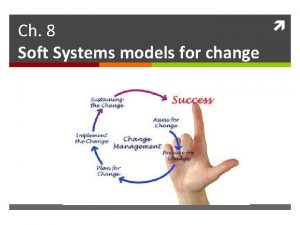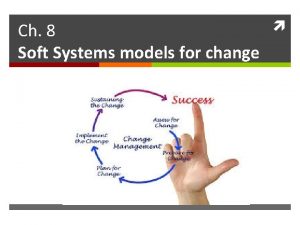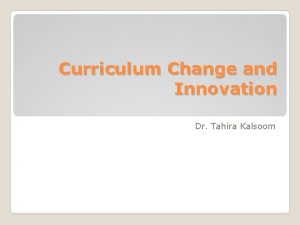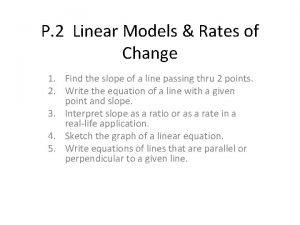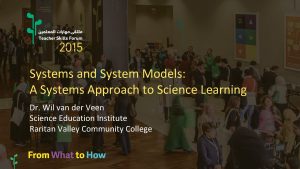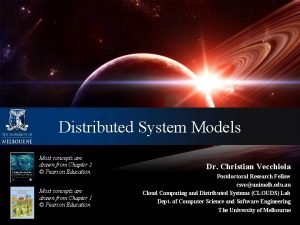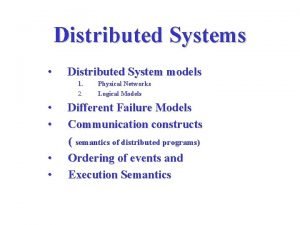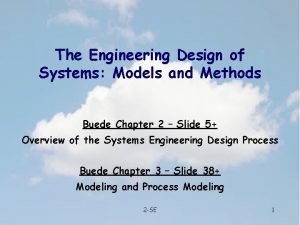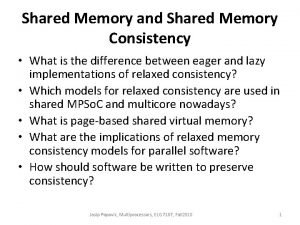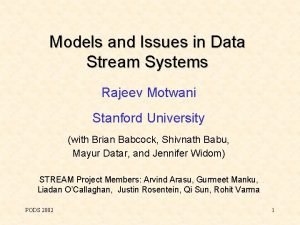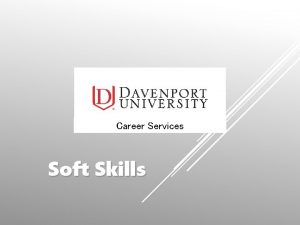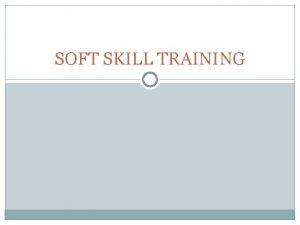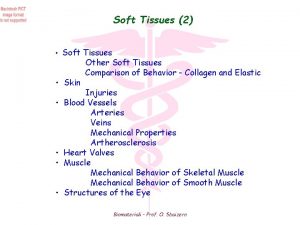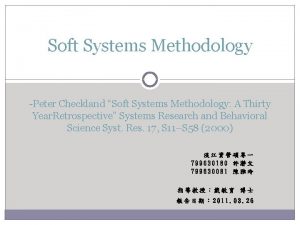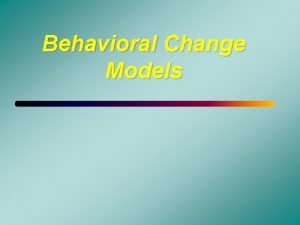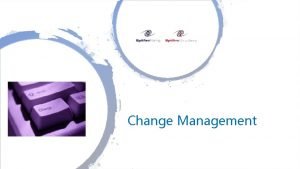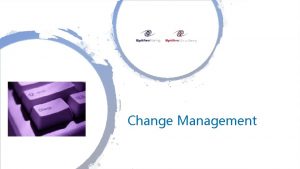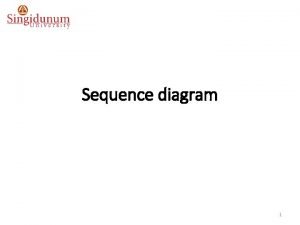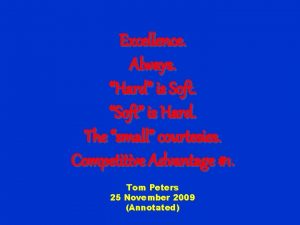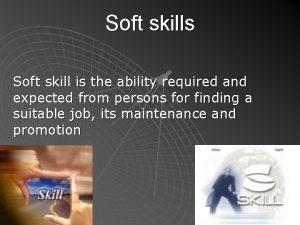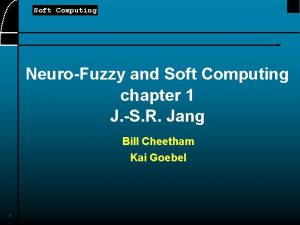Ch 8 Soft Systems models for change Learning

























- Slides: 25

Ch. 8 Soft Systems models for change

Learning objectives: Ø Recognize change situations (problems/opportunities) required soft rather hard than hard systems approaches Ø Consider the philosophy, value orientation & theories of organizational developments as generalized example of soft systems models of change. Ø Outline & describe the processes & practice that comprise most of OD approaches to implement organizational change Explain the hard systems model of change (HSMC) as representative of hard systems methodologies of change Ø Critically review the limitation of OD approaches to managing change.

Managing change in situations of soft complexity Ackoff (1993) identifies three different kinds of things that can be done about problems – ‘they can be resolved, solved or dissolved’

Managing change in situations of soft complexity The challenges of rationality § People make decisions & choices according to some rational mode; of decision making § People do act according to their own view of what is rational for them § OD is an an umbrella term for a set of values and assumptions about organizations and people, which useful for bringing about long-term change to dissolve problems than resolve or solve them.

Organizational Development-Philosophy & underlying assumptions OD definition Is a long term effort, led & supported by top management, to improve an organization's visioning, empowerment, learning and problem-solving processes through an ongoing, collaborative management of organization culture

Organizational Development. Philosophy & underlying assumptions some distinguishing characteristics of OD approach to Change 1. It emphasize goals & process but with a particular emphasis on processes – the nation of organizational learning 2. It deals with change over the medium to long term (change that need to be sustained over a significant period of time. 3. It involves the organization as a whole as well as its parts 4. It is participative, drawing on theory and practices of the behavioural sciences 5. It has top management support and involvement 6. It involves a facilitator who takes on the role of a change agent 7. It concentrates on planned change but as a process that can adapt to a changing situation rather than as a rigid blueprint of how change should be done

Soft system & three critical assumptions The significance of people in organizations The significance of organization as a system The significance of organization as learning organization

The significance of people in organizations The OD approach to change cares about people & believes that people at all levels of an organizations are individually & collectively, both the drives of change. Paton & Mc. Calman (2008) offer three fundamental concepts with respect to the management of people: 1. Organization are about people 2. Management assumptions about people often lead to ineffective design of organizations & this hinders performance 3. People are the most important asset & their commitment goes a long way in determining effective organization design and development.

The significance of people in organizations Assumption regarding people in groups: 1. People in general are social beings and form groups informally. 2. For groups to be effective all group member must share in problem solving & work to satisfy both task & group member needs. 3. OD approaches to change assume that work groups and teams are essential element in the process of designing and implementing change.

The significance of organization as a system Organization are systems of interconnected & interrelated subsystems that includes more formal organizational structures & process as well as culture, policies, style of leadership This idea is one of the most important assumptions of OD as a process of facilitating change because: 1. It reinforces the systemic nature of organizational life & the fact that changes in one part of the organization will impact on operations on another part

The significance of organization as a system 2. A single important cause of change with clear effects can be found, as well as the assumption that any cause and its effect are necessarily closely related in space & time 3. Any organization is a balance of forces built up & refined over a period of time, consequently proposed change of any significance will change this balance & then encounter resistance.

The significance of organization as learning organization The two present idea of (the significant of people in organization & the significant of organization as a systems) come together that for organizations operating in complex environment, the only way to survive is to be a learning organization. Learning organization is built upon the proposition that there is more than one type of learning which can be: - Single-loop & Double- loop (Argyris & Schon, 1996) - Adaptive & generative (Senge, 1990)

The significance of organization as learning organization Single-loop & Double- loop: systems of change that either goal oriented or process oriented - Goal oriented: is directed towards changing the means by which goals are achieved. It concerned with doing things better. - Process oriented: those with goals, focus more on fostering a change process that enable the goal to be challenged. Is concerned with doing the right things - Both types of learning (Single-loop & Double- loop/ Adaptive & generative) involves issues with organizational structure, culture, and leadership style that support this type of learning.

The OD Process OD is at heart a process of facilitation of organizational change & renewal It operates at all levels of the organization- individual, group and organizational. It is relatively long-term process for initiating and implementing planned change It takes into account the messy nature of many organizational problems.

Lewin’s three-phase model of change Most OD models of change consist of a series of phases or steps and Lewin’s Model of change is the most influential models of planned change. Three steps of this model are: - Unfreezing: concerns the ‘shaking up’ of people’s habitual modes of thinking & behaviors to increase their awareness of the need for change. - Moving: the process of making the actual changes that will move the organization to the new state - Refreezing: involves the stabilizing of change, which required securing the change against ‘backsliding’ & may include brining new staff who are not influenced with the old habits.

OD- an action research based model of change Research based model of change involves the following steps: 1. Management & staff perception of problems 2. Data gathering & preliminary diagnosis by those concerned with leading the change 3. Feedback to key client, management & those involved in the change 4. Joint agreement of the problem(s) 5. Joint action planning 6. Implementation 7. Reinforcement & assessment of the change

Doing Action research in your own organization

Stages of OD model of chnage Stage 1 a & 1 b: The present & the Future - Stage 1 a: Diagnose current situation: where environmental analysis of change are useful as tools for diagnosing triggers for change - Stage 1 b: Develop a vision for change: what need to be change comes out of the process of organizational diagnosis and creative thinking (can be called as creative stage)

Stages of OD model of chnage Stage 2: Gain commitment to the vision & the need for change. - This where feedback from the result of stages 1 a & 1 b is most important - The process of gaining commitment to change must include working at the group level of the organization & recognize the influence of both formal & informal leaders.

Stages of OD model of change Stage 3: Developing an action plan - It’s the beginning of managing transition phase from the organization current state to the desired future state. - Critical issues must be consider at this stage, which is: 1. Who is to guide the planning, & the implementation of the change 2. What need to change to achieve the vision 3. Where any intervention should take place

Stages of OD model of change Stage 4: Implement the change This stage involves different levels of analytical focus of the change activities: - Survey feedback - Organizational mirroring - Role negotiation - Process consultation - Team building

Stages of OD model of change Stage 5: Assess & reinforce the change - Assessing change In soft system assessing change concern with messy situation related to attitude, behaviors and cultural norms. - Reinforcing & consolidating change It’s the hardest part where its pointless to expecting people’s behaviors to change if this is not reinforced by concomitant changes in personal polices & practices.

The OD Model of Change

An assessment of the OD model for change OD does not always face up to harsh realities of change OD is limited when change situations are constrained OD requires out of the ordinary leadership OD fits uneasily with the structures 7 culture in the public sector OD does not work in all cultures

Thank You
 Hard and soft system model of change
Hard and soft system model of change Hard and soft system model of change
Hard and soft system model of change Modals and semi modals
Modals and semi modals Cuadro comparativo e-learning b-learning m-learning
Cuadro comparativo e-learning b-learning m-learning Sources of curriculum change
Sources of curriculum change Linear models and rates of change
Linear models and rates of change Systems and system models
Systems and system models System models in distributed systems
System models in distributed systems Distributed system models
Distributed system models The engineering design of systems: models and methods
The engineering design of systems: models and methods Intel processor
Intel processor Models and issues in data stream systems
Models and issues in data stream systems Kontinuitetshantering i praktiken
Kontinuitetshantering i praktiken Typiska drag för en novell
Typiska drag för en novell Nationell inriktning för artificiell intelligens
Nationell inriktning för artificiell intelligens Vad står k.r.å.k.a.n för
Vad står k.r.å.k.a.n för Varför kallas perioden 1918-1939 för mellankrigstiden
Varför kallas perioden 1918-1939 för mellankrigstiden En lathund för arbete med kontinuitetshantering
En lathund för arbete med kontinuitetshantering Kassaregister ideell förening
Kassaregister ideell förening Personlig tidbok fylla i
Personlig tidbok fylla i Sura för anatom
Sura för anatom Densitet vatten
Densitet vatten Datorkunskap för nybörjare
Datorkunskap för nybörjare Boverket ka
Boverket ka Hur skriver man en tes
Hur skriver man en tes Autokratiskt ledarskap
Autokratiskt ledarskap
